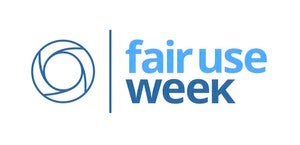
Welcome to Fair Use Week! As libraries and universities across the United States celebrate fair use, you may be wondering just what the fair use doctrine is, and why it matters in academic research. In short, fair use is a particularly important aspect of U.S. copyright law that enables people to use copyrighted work in ways that might otherwise be considered violations of copyright. Fair use allows for activities like quoting other people’s work in papers, quoting texts for literature analysis, and reconfiguring text and information to make a search engine. Fair use prevents copyright law from stifling research and criticism. Unlike other copyright exceptions, fair use only has guidelines, not clear-cut rules, and is largely understood by how it has previously been applied in the courtroom. This can make it seem intimidating, but the principles and analysis of fair use are easy to understand and apply to fit your own research needs.
Fair use is integral to the modern research process. You likely rely on fair use in your academic writing without realizing it! Without fair use, you would need to get permission from copyright holders to reproduce any part of someone else's work, academic or otherwise. Imagine having to get permission just to quote someone’s article in your own work! And what do you think your chances would be of getting someone’s permission if you were criticizing their work? You have also relied on fair use if you have ever quoted a book in a review or literature analysis, or reproduced images or any other kind of media for the sake of research and analysis. Building upon, criticizing, and commentating on the work of other researchers is a core part of how we create knowledge. Without fair use, the entire process of research and scholarly communication would look vastly different!
Given that researchers rely on fair use every day, it helps to understand some of the guidelines underlying fair use. You may have heard some myths about fair use, like that all academic uses are fair, or that you can always use 10% of a book or 2 minutes of a video. Unfortunately, these are only myths, as fair use is not defined by simple rules like these. However, there are some general guidelines you can follow that will increase the likelihood of your use being considered fair. Academic uses do tilt the use in your favor, and you are more likely to be engaging in fair use if you are doing academic, non-commercial work. Commentary, criticism, and supporting an argument typically weigh in favor of fair use. Fair use also requires that the amount of another person’s work you use is reasonable. There are no specific amounts that will always be considered fair but it helps to ask yourself “Am I using more than I need to to make my point?”. In particular, whenever you are using a work under fair use, the use must have a substantive and not a decorative purpose. Using images or even quotes just to add visual or narrative interest, rather than for serious criticism or commentary, is not likely to be considered a fair use. Remember that fair use doesn’t just apply to the text in books and articles, but can also be applied to tables and charts, images, posters, or any other kind of creative work.
If you are interested in learning more about how fair use applies in your own work, or how to conduct a fair use analysis of your own, the library is here to help. Our Copyright Library Guide provides a wealth of helpful educational resources and practice guidelines relevant to academic researchers. Our recently published Applying Fair Use in Academic Writing tutorial will teach you when and how to conduct a fair use analysis of your own. And as always, feel free to reach out to the Researcher Support team!
